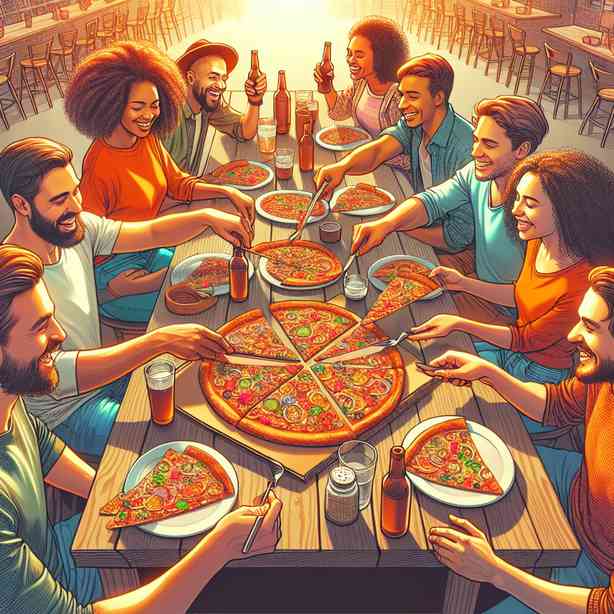
The experience of everyone gathering around a table, filled with pizzas of various flavors, evokes a sense of warmth, camaraderie, and nostalgia. It is not just about the food; it’s about the connections formed during these moments. This article dives into the multifaceted emotions and social dynamics encapsulated in that feeling when everyone’s eating pizza, exploring the cultural significance, personal memories, and even the science behind our love for this iconic dish.
Pizza has transcended mere sustenance; it has become a global symbol of togetherness. Originating from Italy, pizza was once a humble meal consumed by the working class. However, it has evolved into a worldwide favorite, embraced by diverse cultures. Each region adds its unique twist, whether it’s the deep-dish style of Chicago, the thin-crust of New York, or even the inventive toppings found in gastronomical hubs like Tokyo and Sao Paulo. This adaptability illustrates how pizza has become a unifying food, capable of bringing people from different backgrounds together.
Sitting around a table sharing pizza fosters a communal spirit. The act of breaking bread— or, in this case, breaking pizza— is laden with symbolism. It encourages sharing and mutual enjoyment, prompting conversations and laughter. When people share food, especially something as universally loved as pizza, barriers tend to dissolve. Strangers become friends, families bond over slices, and relationships strengthen. This phenomenon can be attributed to the inherent social nature of humans; we are wired to connect through shared experiences.
Moreover, pizza evokes nostalgia for many. For some, it may remind them of childhood birthday parties, late-night study sessions in college, or family movie nights. These associations are often coupled with powerful emotions. The aroma of freshly baked pizza can transport individuals back to simpler times when life felt uncomplicated. Our memories are often tied to the sensory experiences of taste and smell, making pizza not just a meal but a nostalgic experience that can elicit joy and comfort.
Additionally, the customization potential of pizza allows individuals to feel a sense of ownership over their meal. From choosing the dough and sauce to selecting a myriad of toppings, each person can create a pizza that perfectly aligns with their taste preferences. This empowerment in personal choice enhances the joy of sharing; everyone at the table can delight in something tailored to their liking while still enjoying the collective experience. Such personalization not only satisfies individual cravings but also accentuates the interplay between communal and individual enjoyment.
In discussions about pizza, one cannot overlook the role of technology and social media in the modern dining experience. Social platforms offer a space for people to share their unique pizza creations or exciting pizza outings, igniting a chain of enthusiasm among friends and followers. The act of posting a picture of a beautifully crafted pizza slice often sparks conversations and encourages others to partake in similar experiences, reinforcing the bond that food creates among individuals. Additionally, online ordering has made it easier than ever for friends and families to share pizzas, irrespective of location, allowing for virtual gatherings that mimic the real thing.
Delving deeper into the science of why we love pizza unveils a fascinating interplay of psychology and physiology. Pizza is typically a combination of carbohydrates, fats, and proteins, creating a perfect storm of flavors and nutrients. The blend of cheese and tomato sauce releases dopamine in the brain, eliciting pleasure and satisfaction. This reaction can be heightened by the social settings in which we consume pizza, resulting in a double dose of happiness. Thus, it’s no surprise that pizza is often a go-to comfort food, offering solace in times of stress or celebration alike.
As we consider the current global landscape, the communal aspect of sharing pizza takes on added significance. In recent times, the pandemic has led to isolated living situations for many, which has heightened the value of social gatherings. Pizza parties, virtual or in-person, have become opportunities for connection, allowing friends and family to come together in a world that sometimes feels divided. Sharing a pizza, even through a video call, offers a semblance of normalcy and a chance to connect with loved ones, reminding people of the inherent importance of community.
In conclusion, the feeling when everyone’s eating pizza encompasses much more than a shared meal; it captures the essence of human connection, nostalgia, and joy. Pizza serves as a cultural symbol that brings diverse people together, facilitating relationships and fostering community. Whether enjoyed on a special occasion or a casual weeknight dinner, pizza remains a beloved comfort food capable of uniting people in various ways. As we navigate the complexities of modern life, let us not forget the simple pleasure of sharing a slice, cherishing the moments that bring us closer together. After all, it’s in these shared experiences that we find the true happiness of being human.


